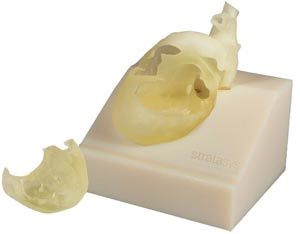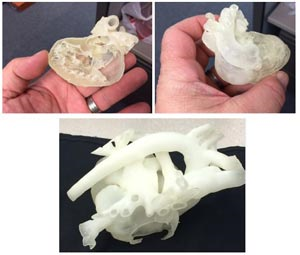3D printed pre-surgical planning models, based on patients’ scans, are being used all over the world with the goal of improving accuracy and efficacy of complicated surgeries. Now, a new study, 3DHEART, is examining the impact of patient-specific 3D printed models in pre-operative planning for pediatric heart surgery. This randomized, single-blind clinical trial is open to its first patient enrollments this week.
3D printed replicas of pediatric hearts allow physicians to evaluate and interact with patient anatomy in ways 2D images cannot.
Stratasys will support the project with 3D printing of the models to be used in the trial. 3D printed replicas of pediatric hearts allow physicians to evaluate and interact with patient anatomy in ways 2D images cannot.
“This study is truly extraordinary, in that it is a ‘village’ effort. Doctors have seen first-hand how 3D printing can save lives, but they have not had the resources to quantifiably substantiate heretofore anecdotal evidence. This study will do that. I am proud to work with such an esteemed group of clinicians and industry leaders to improve the lives of children like my daughter, and I thank Stratasys for their unwavering support,” said OpHeart Executive Director, Anne Garcia.
The study is being led by physicians from New York-Presbyterian/Morgan Stanley Children's Hospital, Children’s Hospital of Philadelphia, Children’s National Medical Center, and Phoenix Children’s Hospital, with up to 20 additional sites in the United States.
“This study is incredibly important because it will finally quantify what we know from first-hand experience: 3D printed patient-specific models improve surgery, improve outcomes and result in lower treatment costs,” said Dr. Yoav Dori, Pediatric Cardiologist, Children’s Hospital of Philadelphia. “If we can empirically demonstrate this, it will be a game-changer for treating not only children with congenital heart defects, but patients across the board.”
The study will focus on pediatric congenital heart patients requiring complex two-ventricle repair. The primary endpoint being studied is cardiopulmonary bypass time, with secondary endpoints including the prevalence of surgical complications (morbidity), mortality, and physician assessment of utility. The study is being managed by OpHeart, is a 501(c)3 nonprofit organization whose mission is to improve the odds and outcomes for children born with life-threatening heart defects.
Examples of 3D printed pediatric heart models. 3D printed in soft, translucent TangoPlus 3D printing material, the models can be operated upon prior to the actual surgery
In total, the study will be made up of 400 pediatric patients. Stratasys Direct Manufacturing, one of the world’s largest 3D printing and advanced manufacturing service providers, is 3D printing heart models for 200 patients on Stratasys Connex multi-material, full color 3D Printers. These models are based on the patients’ MRI or CT scans and enable the surgeon to evaluate and “practice” on an accurate replica of the patient’s heart prior to actual surgery. The results of these 200 patients are being compared to the results of 200 patients who are being treated without the aid of 3D printed heart models.
“Stratasys Direct Manufacturing is honored to contribute to such an impactful study with the potential to revolutionize surgical planning and change patients’ lives for the better,” said Greg Reynolds, VP of Additive Manufacturing at Stratasys Direct Manufacturing. “We understand the critical nature of this work and we’ve worked with the study investigators to develop a robust and responsive production process that puts these models in surgeons’ hands in as little as three days.”

